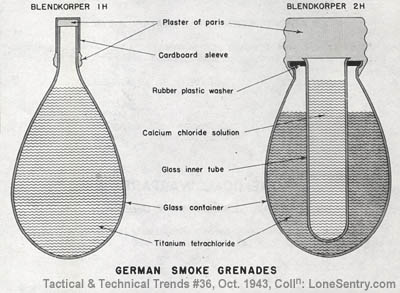Blendkorper 1 H

This munition consists of a tear-drop shaped flask, 6 inches long with a maximum diameter of 2-1/2 inches, sealed at the upper end by drawing out the flask. The sealed tip is protected by a cardboard sleeve, sealed with a plaster of Paris type material. The flask weighs 13.2 ounces with 10.6 ounces of amber-colored titanium tetrachloride, (FM).
The munition is used by throwing against a hard surface which breaks the flask. The titanium tetrachloride then vaporizes, forming a smoke cloud which varies greatly with the relative humidity, being dense at a high humidity and thin at a low humidity.
The grenades are individually packed in a hexagonal, three-ply, corrugated paper container 6-1/2 inches long, by 3 inches square, wrapped in a transparent cellulose material. The top of the box has a handle which when pulled, removes the cover and flask. A label on the box gives in German the following directions:
Smoke Grenade 1 H
(BK 1 H)
Directions for use.
- For carrying, leave the smoke grenade in the cardboard box.
- For throwing, remove the smoke grenade from the box; draw out the cover with the smoke grenade hanging in the band; take the smoke grenade in the throwing hand and remove the cover. 3. Throw the smoke grenade with force at the target, peephole, sights, etc.

Blendkorper 2 H
The grenade consists of a pear-shaped, glass outer flask, resembling a large electric light bulb, almost filled with a brown liquid. Inside is a long tube filled with a clear liquid; both are capped with a sulphur and plaster of Paris cement. The total weight is slightly over seven ounces.*
The outer flask is a pear-shaped glass bulb, 2-1/2 inches in diameter at the widest point, 3-15/16 inches in height to the neck, where it flares out 1/8 inch and forms a collar approximately 1 inch in height and 1-1/2 inch in diameter. This flask contains 8.75 ounces of titanium tetrachloride.
The inner glass tube is 3 7/8 inches long and 7/8 inch in diameter, resembling a test tube with the upper end sealed off; the weight is a little under an ounce. The upper end has a slight shoulder which rests on a rubber-like plastic washer; this washer in turn rests on the inside shoulder of the collar of the outer flask; thus, when the cementing material was poured, the inner tube was firmly sealed within the neck of the outer flask. The inner tube contains about 1.2 ounce of a 27 per cent solution of calcium chloride.
The smoke is produced by hydrolysis of titanium tetrachloride. The purpose of the inner tube of calcium chloride solution is to provide water to react with the titanium tetrachloride and produce an instantaneous smoke cloud in the desert or in cold areas, where the low humidity would cause a slow reaction. The calcium chloride is probably added to keep the water from freezing.
This grenade was received in a cardboard box, 6-1/4 inches high, 3-3/4 inches wide, and 12-1/2 inches long, with separate compartments for each grenade; capacity four grenades. A label on the front of the box gave in German the following directions for use:
4 Screening Devices - 2H
(BK 2H)
Useable and freeze-proof to -40°C**
-
Carrying:
Leave the Blendkörper in the closed carton. -
Taking Out:
Tear where indicated around the top at 1. Lift up the top, and tear out the Blendkörper. Take Blendkörper 2, 3, and 4 in the same way. 3. Throwing:
Grasp the Blendkörper in the hollow of the hand, the round part toward the index finger. Throw with force at the target.
*Apparently, this is the weight of the container. The total of all weights given is approximately 22 ounces.
**Equivalent to 40 degrees below zero, Fahrenheit - the only point at which the two scales coincide.















